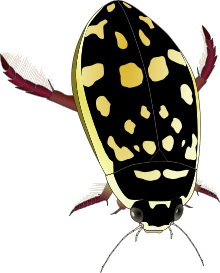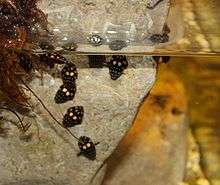Thermonectus marmoratus
| Sunburst Diving Beetle | |
|---|---|
 | |
| Scientific classification | |
| Kingdom: | Animalia |
| Phylum: | Arthropoda |
| Class: | Insecta |
| Order: | Coleoptera |
| Suborder: | Adephaga |
| Family: | Dytiscidae |
| Genus: | Thermonectus |
| Species: | T. marmoratus |
| Binomial name | |
| Thermonectus marmoratus Gray, 1832 | |
Thermonectus marmoratus is a relatively colorful North American species of diving beetle known by the common names sunburst diving beetle and spotted diving beetle.[1] The beetle has recently become notable when it was discovered that its aquatic larval stage has been found to have used in its principal eyes two retinas and two distinct focal planes that are substantially separated, in the manner of bifocals to switch their vision from up-close to distance, for easy and efficient capture of their prey, mostly mosquito larvae. This is the first ever recorded use of bifocal technology in the animal world.[2]
Because of their bright colors, they are often displayed in zoos, sometimes together with Abedus herbert (also found together in the wild[3]) and other aquatic beetles.[4]
Description

The adult beetle has a length of 0.8–1.5 cm (0.31–0.59 in),[5][6] with females slightly larger than males. The sunburst diving beetle has a black and streamlined carapace covered with bright yellow or golden spots. The male has a suction disk on each foreleg.[7][8]
Behavior and distribution
Sunburst diving beetles live in water and swim well.[1][7] They inhabit various slow-moving freshwater habitats, especially shallow, temporary or intermittent pools and creeks (arroyos) with little or no aquatic vegetation.[6][9] When their water source dries up they will fly to a new one.
Sunburst diving beetles are found in extreme Southern California (mainly Peninsular Ranges),[6] southern Utah,[10] Arizona, New Mexico, Texas (where first recorded in 1996), and Mexico.[11]
Diet
Sunburst diving beetles are predators and scavengers of small animals, especially invertebrates such as other aquatic insects and snails, but also small vertebrates such as young fish and tadpoles. If available, they prefer to feed on small, already dead soft-bodied animals.[3] These beetles are useful because they eat mosquito larvae and pupae. They have also been observed swarming a prey item and feeding en masse. In captivity, these beetles will feed on flake fish food and live crickets.[12][13]
References
| Wikimedia Commons has media related to Thermonectus marmoratus. |
- 1 2 MORGAN, R.C. (1998). "5". "Windows on the Water World," Backyard BUGwatching. pp. 4–6.
- ↑ Dawn Fuller (duly edited) (24 August 2010). "Bug With Bifocals Baffles Biologists". ScienceDaily. ScienceDaily LLC. Retrieved 25 August 2010.
- 1 2 J. Velasco; V.H. Millan (1998). "Feeding Habits of Two Large Insects from a Desert Stream: Abedus herberti (Hemiptera: Belostomatidae) and Thermonectus marmoratus (Coleoptera: Dytiscidae)". Aquatic Insects. 20 (2): 85–96. doi:10.1076/aqin.20.2.85.4500.
- ↑ O’Sullivan, T. "Captive rearing study of the Thermonectus marmoratus" (PDF). St. Louis Zoo. Retrieved 9 April 2018.
- ↑ "Sunburst Diving Beetle - Thermonectus marmoratus". arizonensis.org. Retrieved 9 April 2018.
- 1 2 3 A.V. Evans; J.N. Hogue (2006). Field Guide to Beetles of California. University of California Press. p. 73. ISBN 978-0-520-24655-3.
- 1 2 EVANS, D.L.; SCHMIDT, J.O.; EDs. (1990). Insect Defenses, Adaptive Mechanisms and Strategies of Prey and Predators. State Univ. of New York Press, Albany. pp. 482 pp.
- ↑ MILNE, L; MILNE, M. (1980). "Marbled Diving Beetle (Thermonectus marmoratus)," The Dobbin Society Field Guide to North American Insects and Spiders. Alfred A. Knopf, NY. pp. 542+ plate 96.
- ↑ "Species Thermonectus marmoratus - Sunburst Diving Beetle". BugGuide. Retrieved 9 April 2018.
- ↑ Vinson, M. (15 May 2002). "Aquatic Ecosystems and Invertebrates of the Grand Staircase-Escalante National Monument" (PDF). Utah State University. Retrieved 9 April 2018.
- ↑ Shaverdo, H.V. (2005). Konstantinov, Tishechkin, Penev, ed. "New Records of Some Species of Diving Water Beetles (Coleoptera: Dytiscidae) from the Palearctic and Nearctic Regions". Contributions to Systematics and Biology of Beetles Papers Celebrating the 80th Birthday of Igor Konstantinovich Lopatin: 327–331.
- ↑ Arnett Jr, R.H.; Jacques Jr, R.L. (1981). "Thermonectus marmoratus," Simon and Schuster's Guide to Insects. New York, Toronto and London: Simon and Schuster Inc. pp. 86–87.
- ↑ MORGAN, R.C. (1992). "Natural History, Captive Management and Display of the Sunburst Diving Beetle Thermonectus marmoratus," AAZPA/CAZPA Annual Conference Proceedings. pp. 457–464.